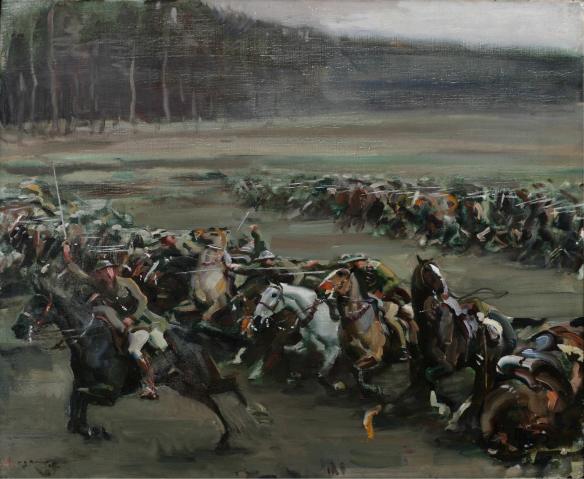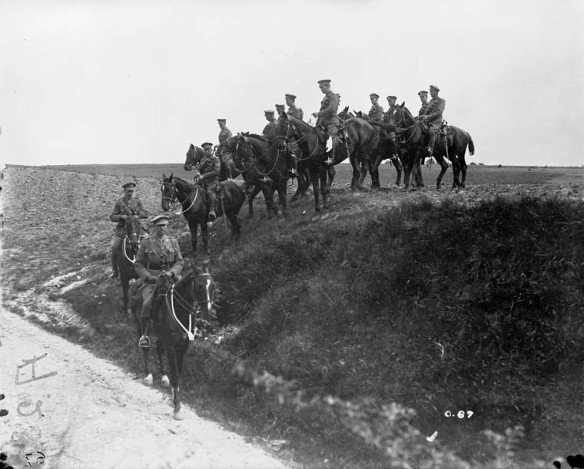By Ethan M. Coudenys
Shells were falling, machine guns were firing, and horses were whinnying as the final cavalry charge of the Great War on the Western Front took place at Moreuil Wood. The line had broken, and Field Marshal Douglas Haig called for the Canadian Cavalry Brigade—specifically the Lord Strathcona’s Horse—to charge through the gap in the line to advance further into German-controlled territory. This ill-fated charge would be the last wartime charge for the Canadians in military history.

Sir Alfred Munnings
The Charge of Flowerdew’s Squadron
CWM 19710261-0443
Beaverbrook Collection of War Art
Canadian War Museum
March 30, 1918, was the mid-point of the 100 Days Campaign—a campaign which saw incredible advances through German-controlled lines on the Western Front and the beginning of the final phase of the First World War. At Moreuil Wood, the infantry and artillery attacks had, in the opinion of the generals commanding the attack, broken the German defensive line, and for the first time since 1914, the Canadian Cavalry Brigade would remount and attack.
Between January 1915 and early 1918, cavalry soldiers—referred to as “troopers”—took on the role of infantry personnel. They worked in the same trenches as all the other soldiers and were required to defend and attack using the same tactics as the infantry. For all intents and purposes, they were infantry troops, however, they also had to pack their kits according to their actual designation: cavalry troopers. They were therefore always required to carry their tack, feed and water for their mounts, rations and water for themselves, ammunition, etc. Yet, they were not given the same packs as infantry troops. They were able to hold some of these supplies in their saddlebags, but they had to transport heavy equipment without a proper way of storing it.

Lord Strathcona’s Horse in 1916, moving behind the front line (a000119).
Despite the negligible use of cavalry on the Western Front after the first months of the Great War, the cavalry remained at the forefront of the minds of those planning Allied offensives. In Great Britain, the General Planning Staff was largely composed of cavalry officers, and Douglas Haig was one of them. Cavalry was therefore considered vital to winning the war against the German Empire. Rarely used in battle as actual cavalry troopers, this final charge proved, once and for all, that in modern warfare, the cavalry was of little strategic value.
On that fateful day, Lieutenant Gordon Muriel Flowerdew led the Lord Strathcona’s Horse Company C cavalry group on two charges against a myriad of German defensive positions. Three hundred German infantrymen defended their position. Using the feared MG-08 heavy machine gun and the newly invented light machine gun, they mowed down the advancing cavalry within minutes. Nevertheless, the only surviving trooper remembers Lieutenant Flowerdew shouting “It’s a charge, boys! It’s a charge!” Racing at a full gallop, the squadron met the German Army, but ultimately failed in its attempt to take the position.
This earned Flowerdew the Victoria Cross, the highest award for bravery in the British Commonwealth. However, Flowerdew’s story did not end happily since his squadron lost all but one trooper in the attack.
Today, at Moreuil Wood, a small memorial commemorates the sacrifice made by Company C of the Lord Strathcona’s Horse. The battlefield there is strewn with the remains of the attacking Canadian horses, their men, and the German soldiers who defended their line. This was the last charge of the Canadian Cavalry Brigade. After the Second World War, the Canadian Cavalry Brigade was largely reorganized into armoured, tank and motorized corps. All but a small number of troopers were assigned ceremonial roles in the Royal Canadian Army.
Unfortunately, no wartime photographers were able to capture the final charge of Company C, led by Lieutenant Flowerdew, but the famous British painter, Sir Alfred Munnings, captured the moment and immortalized it in an oil painting completed in the 1920s. The painting is now held at the Canadian War Museum.
Additional resources
- Lieutenant Gordon Muriel Flowerdew, VC, by Emily Monks-Leeson, Library and Archives Canada Blog
Ethan M. Coudenys is a Genealogy Consultant at Library and Archives Canada.
